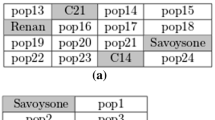Abstract
Farmer participation is increasingly seen as a key to develop technologies which are more relevant to farmers' communities. In plant breeding, farmer participation is seen as key to increase the probability of adoption of new varieties. This paper addresses the issue of selection efficiency in participatory plant breeding by testing the effect of selection environment and of who did the selection in one cropping season (1997) on the performance of the selected lines in the following cropping season (1998). Selection environment had a larger effect on response to selection than who did the selection, confirming the importance of decentralized selection. Selections made by the breeder and the farmers in 1997, differed in 1998 for a number of traits, but seldom for grain yield. When the difference for grain yield was significant, breeder's selection was more effective on station, while farmers' selection was more effective in farmers' fields. The results of this study indicate that it is possible to organize a plant breeding program with the objective of adapting crops to a multitude of both physical and socio-economic environments: such a breeding program will, at the same time, increase productivity and stability, enhance biodiversity and produce environmentally friendly cultivars.
Similar content being viewed by others
References
Ceccarelli, S., S. Grando & A. Impiglia, 1998. Choice of selection strategy in breeding barley for stress environments. Euphytica 103: 307–318.
Ceccarelli, S., S. Grando, R. Tutwiler, J. Baha, A.M. Martini, H. Salahieh, A. Goodchild & M. Michael, 2000. A methodological study on participatory barley breeding. I. Selection phase. Euphytica 111: 91–104.
Ceccarelli, S., S. Grando, E. Bailey, A. Amri, M. El-Felah, F. Nassif, S. Rezgui & A. Yahyaoui, 2001. Farmer participation in barley breeding in Syria, Morocco and Tunisia. Euphytica 122: 521–536.
Ceccarelli, S. & S. Grando, 2002. Plant breeding with farmers requires testing the assumptions of conventional plant breeding: Lessons from the ICARDA barley program. In: D.A. Cleveland & D. Soleri (Eds.), Farmers, Scientists and Plant Breeding: Integrating Knowledge and Practice, pp. 297-332. CABI Publishing, Wallingford, Oxon, UK.
Gilmour, A.R., 1992. TWOD. A program to fit a mixed linear model with two dimensional spatial adjustment for local trend. New South Wales Agricultural Bulletin 1. Tamworth, NSW, Australia.
Gilmour, A.R., B.R. Cullis, S.J. Welham & R. Thompson, 1998. ASRELM. NSW Agriculture, Australia.
DeLacy, I.H., K.E. Basford, M. Cooper, J.K. Bull & C.G. McLaren, 1996. Analysis of multi-environment trials-an historical perspective. In: M. Cooper & G.L. Hammer (Eds.), Plant Adaptation and Crop Improvement, pp. 39-124. CAB International, Wallingford, England.
Genstat 5 Committee, 1997. Genstat 5 Release 4.1: Reference Manual Supplement. Harpenden, Herts, U.K.: Lawes Agricultural Trust (Rothamsted Experimental Station).
McGuire, S., G. Manicad & L. Sperling, 1999. Technical and Institutional Issues in Participatory Plant Breeding-Done from a Perspective of Farmer Plant Breeding: a Global Analysis of Issues, and Current Experience. Working Document No. 2. CGIAR, Systemwide Program on Participatory Research and Gender Analysis for Technology Development and Institutional Innovation. March 1999, Cali, Colombia.
Sarker, A., M. Singh & W. Erskine, 2001. Efficiency of spatial methods in yield trials in lentil (Lens culinaris ssp. culinaris). J Agric Sci, Cambridge 137: 427-438. Singh, M., R.S. Malhotra, S. Ceccarelli, A. Sarker, S. Grando & W. Erskine, 2003. Spatial variability models to improve dryland field trials. Exp Agric 39: 1-10. Soleri, D., D.A. Cleveland, S.E. Smith, S. Ceccarelli, S. Grando, R.B. Rana, D. Rijal & H.R. Labrada, 2002. Understanding farmers' knowledge as the basis for collaboration with plant breeders: methodological development and examples from ongoing research in Mexico, Syria, Cuba and Nepal. In: D.A. Cleveland & D. Soleri (Eds.), Farmers, Scientists and Plant Breeding: Integrating Knowledge and Practice, pp. 19-60. CABI Publishing, Wallingford, Oxon, UK. van Eeuwijk, F.A., M. Cooper, I.H. DeLacy, S. Ceccarelli & S. Grando, 2001. Some vocabulary and grammar for the analysis of multi-environment trials, as applied to the analysis of FPB and PPB trials. Euphytica 122: 477-490. Watson, S.H., I.H. DeLacy, D.W. Podlich & K.E. Basford, 1996. GEBEI. An analysis package using agglomerative hierarchical classificatory and SVD ordination procedure for genotype × environment data. Research Report #57. Department of Mathematics, The University of Queensland, Brisbane, Australia.
Author information
Authors and Affiliations
Rights and permissions
About this article
Cite this article
Ceccarelli, S., Grando, S., Singh, M. et al. A methodological study on participatory barley breeding II. Response to selection. Euphytica 133, 185–200 (2003). https://doi.org/10.1023/A:1025535609828
Issue Date:
DOI: https://doi.org/10.1023/A:1025535609828




